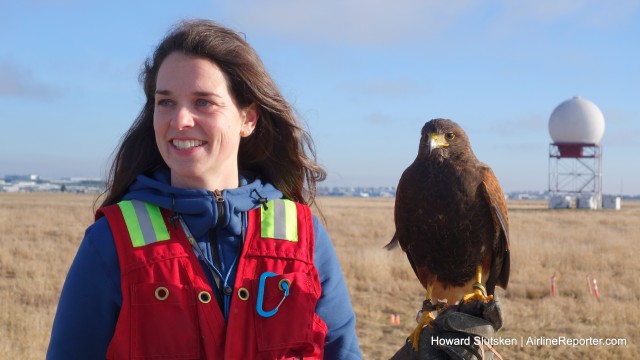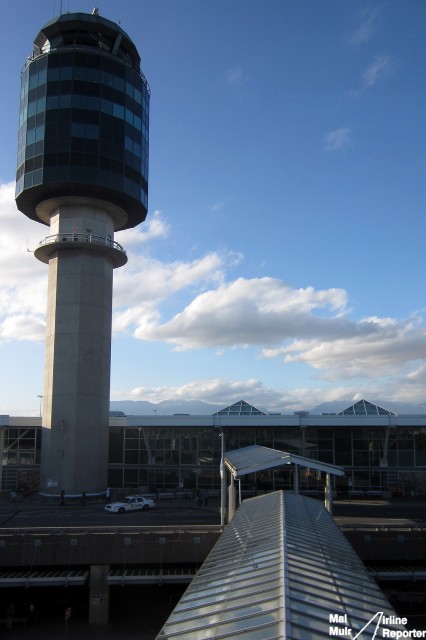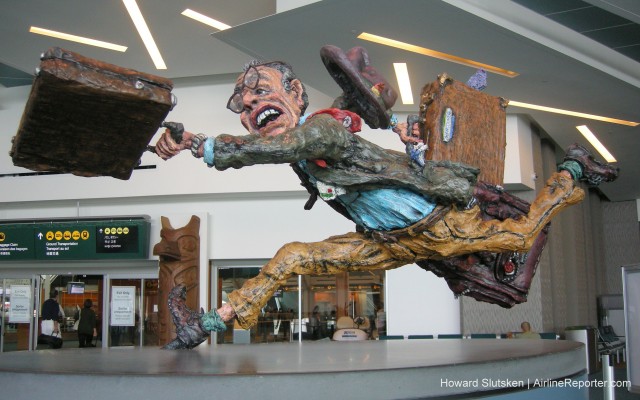
Emily Fleming, Raptor Biologist with Pacific Northwest Raptors, and Goliath, the Harris’ Hawk, in front of YVR’s radar “golf ball”
Airplanes and birds don’t play well together.
Just ask Captain Sully and First Officer Jeff, whose encounter with a flock of Canada Geese turned their A320 into a glider. Or talk to the crews of the approximately 150 planes per year at Vancouver International Airport that report bird strikes. Flight safety can be seriously compromised, repair costs for the airlines are huge, passengers are often inconvenienced, and for the birds, well, it’s fatal.
Vancouver International Airport (YVR) is located on the shores of the Strait of Georgia, on a large island in the Fraser River Delta. And just like the passengers who connect at YVR, the millions of birds that annually use the migratory Pacific Flyway like to stop in the Vancouver area to get something to eat and have a rest. Boundary Bay, south of YVR and the location of the general aviation Boundary Bay Airport (ZBB), is an internationally-recognized Important Bird Area. Even the main Vancouver air navigation aid, the YVR VOR, is on the same island as the renowned Reifel Migratory Bird Sanctuary.

Vancouver’s unique tower dominates the airport skyline – Photo: Mal Muir | AirlineReporter.com
If you are a big AvGeek, then the chances are you have listed in on air traffic control (ATC) somehow. Be it onboard a United flight using their famous Channel 9, listening online using LiveATC, or through a scanner while plane spotting, it’s a familiar sound. But have you ever wondered what life is like from the other side of the microphone? Wouldn’t it be great to see what an airport looks like from the top of the tower, or what it is like to work inside an area control center? Recently Nav Canada gave me that exact opportunity at Vancouver International Airport (YVR) and I wanted to share.
Nav Canada, a not-for-profit private company, controls the airspace above Canada similar to the FAA in the United States. Vancouver Tower stands tall above the airport at around 140m tall (460ft) and has 360-degree views of the entire area. Although the day I visited the tower did not have the best weather (the cloud deck was really low, unfortunately) the view of the airport was still impressive. On a clear day, you can see all the way to the mountains north of the city (towards Grouse) or down to Victoria in the south. But I was more there for the view inside than the clouds and mountains outside.

Ever feel like this? “The Flying Traveller” by Patrick Amiot & Brigitte Laurent. Just past domestic security of “C” Pier.
I’m really lucky to have Vancouver International Airport (YVR) as my “home base”. YVR has great plane-watching, which is a necessity for AvGeeks, of course, but also has fabulous architecture and design, and is a wonderful place to spend some time. But don’t take just my word for it.
YVR was rated as the Best Airport in North America for the 4th year in a row in the 2013 Skytrax World Airport Awards. YVR ranked 8th overall worldwide, and is the only North American airport to make the Skytrax Top 10 in 2013.
YVR has one, large interconnected terminal that’s divided into areas for Canadian-domestic, international, and U.S. flights. For those who haven’t flown from a major Canadian airport to the States, passengers get to clear U.S. customs and immigration before they get on their flight. It’s the U.S. Customs and Border Protection (CBP) “Preclearance” program.
As the passengers have pre-cleared, the plane lands at its destination as a domestic flight, making passenger arrivals more efficient. At YVR, passengers who have cleared security can pass between the domestic and international areas, but the U.S. area first requires a stop to chat with the CBP officers and a separate security check. Once you’ve been cleared, you’re in “quasi-U.S. territory”. If you leave, you have to go see the Canada Border Services Agency (CBSA) officers and clear customs to get out of the terminal. Interesting…eh?
Part of what makes YVR so unique is the amazing collection of art on display.


